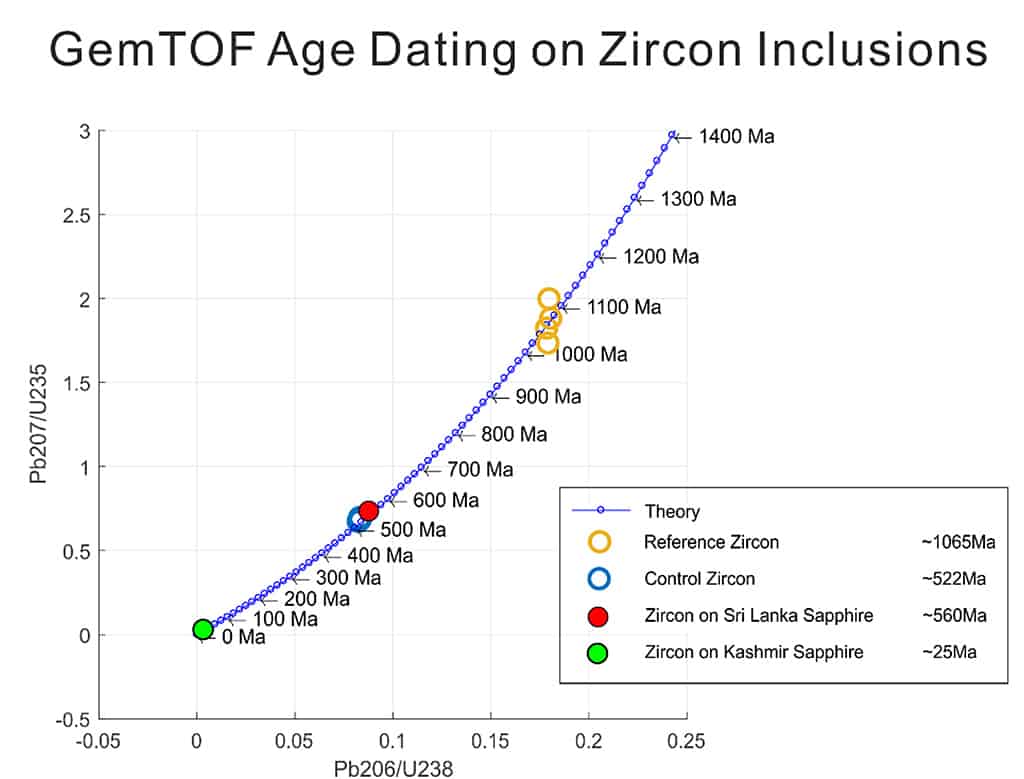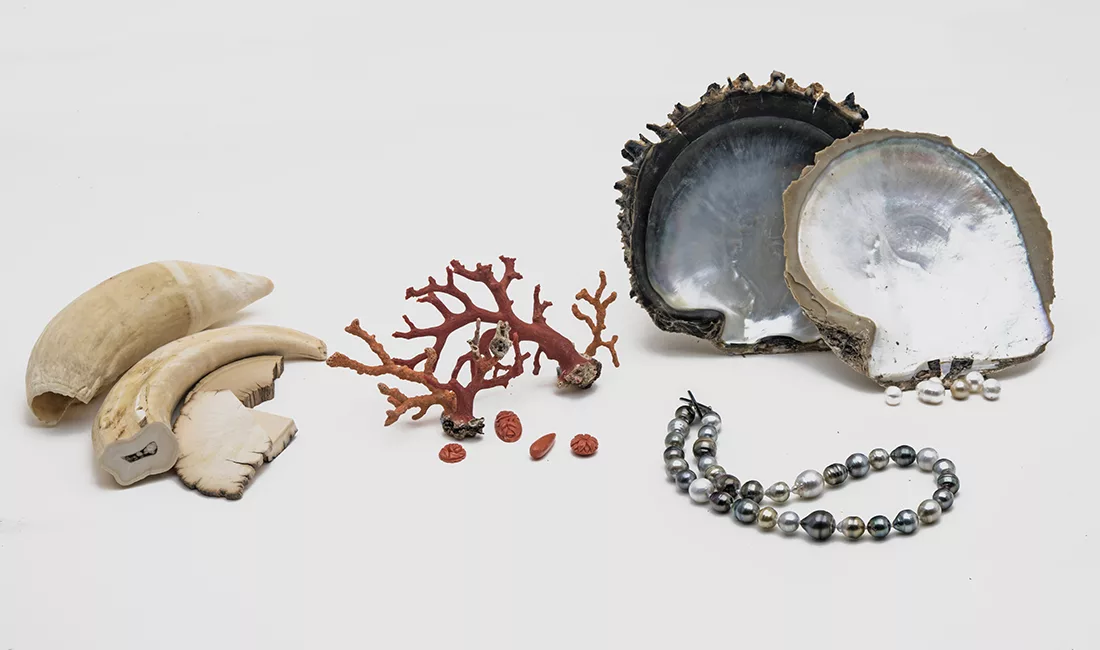
Age dating as a testing procedure for gemstones and biogenic gems
by Dr. M.S. Krzemnicki, first published in Facette 26 (May 2020)
Radiometric age dating is a well-established method in geochronology (Earth sciences) and archaeology. There are numerous studies highlighting the use of radioactive decay of U-Pb, K-Ar (amongst many others) for geological age dating and radiocarbon 14C for biogenic material (bones, shells) of antique to pre-historic age. In gemmology, the application of age dating as an analytical method is still rather limited, although pioneering work was already published many years ago (Coenraads et al., 1990; Sutherland et al., 2002).
With the recent progress of analytical capabilities (e.g. GemTOF: LA-ICP- TOF-MS, see Wang et al., 2016) we have been able in the past few months to carry out radiometric age dating on a large number of gemmological samples, partly from our research collection, but in great number also as part of our testing procedure on gemstones and biogenic materials (pearls and corals) from our clients (Figure 1).

In the context of a gemmological laboratory, radiometric age dating of gem materials or their inclusions is often a very useful addition to data gained by more traditional gem testing procedures. It may bolster conclusions deduced from other tests and may even deliver crucial information without which a conclusion would not be possible.
Supporting Evidence for Origin and Historic Provenance
For gemstones, radiometric age dating is specifically useful in cases where the origin of a gemstone is in question, but could be resolved by knowing its age of formation. Such age dating may reveal that a gemstone is very old, i.e. related to Neoproterozoic to early Palozoic geological events 1000 – 500 million years ago, such as is the case for many gems from Madagascar, East Africa, or Sri Lanka. Or it may conclusively show that it is of much younger age, i.e. related to Cenozoic geologic events 65 – 1 million years ago, such as is the case for sapphires from Kashmir or gemstones from Mogok (Myanmar) (Figure 2). Evidently, age dating– if applicable – can be crucial for lab gemmologists, for example to determine whether a velvety blue sapphire originates from Kashmir or Madagascar. The only drawback for age dating on gemstones is that, in most cases, it is possible to be carried out only if a tiny surface-reaching inclusion is present which can be dated by appropriate methods (see also Link, 2016; Sorokina et al., 2017).

When applying (radiocarbon) age dating to biogenic gem materials such as pearls, we may gain information a) to confirm a historic age (‘provenance’) of a historic pearl (Krzemnicki et al., 2017), and b) it may support the identification of a natural pearl based on its formation age dating prior to pearl cultivation (Krzemnicki & Hajdas, 2013).
Challenges of Age Dating
Radiometric age dating is a promising but complex analytical method with limitations and challenges, well-known and described in literature (Reiners et al., 2018 and references therein). For radiocarbon 14C dating, these include contamination effects from the jewellery mounting, during sampling, or over-assessed ages (i.e. too old) when the skeleton of the biogenic material (e.g. shell, pearl, coral) uses/recycles bicarbonate from older sources (so-called hard water effect, Shotton, 1972). In geochronological dating (e.g. U-Pb of zircon), leaching/contamination effects and complex growth zoning (e.g. old detrital zircon grain is overgrown by a much younger rim) may affect the results considerably, for example resulting in ‘mixed’ ages (Schoene, 2014; Reiners et al., 2018). The ability of TOF-MS to analyse not only a small number of isotopes necessary for age dating, but to provide nearly the full mass spectrum simultaneously is in this respect very helpful (Wang et al., 2019), as it is possible to detect complex growth zoning and epitaxial overgrowth patterns (e.g. zirconolite grown on zircon, Phyo et al., 2020), thus supporting the interpretation of radiometric age dating results.
Age Dating on Client Gemstones
In the past few months we have applied radiometric age dating (Th-Pb and U-Pb) on a large number of corundum and spinel samples, many of them submitted by our clients for testing and origin determination, but also samples studied for a PhD project in collaboration with Basel University (Phyo et al., 2020). For this, we used surface-reaching inclusions present as time-capsules in these gemstones. So far, we were able to apply radiometric age dating not only on zircon inclusions, but additionally on inclusions of zirconolite, xenotime, monazite, baddeleyite, rutile, apatite, and titanite. This range of inclusions considerably increases the ability to apply dating as an additional method in gemmological testing in the laboratory. In addition to this, certain sapphires may contain considerable trace amounts of high-field-strength-elements (HFSE) such as Sn, Nb, Ta, W, Pb, Th, U, presumably accumulated as fine dispersed sub-microscopic (syngenetic) inclusions within these sapphires (Shen et al., 2009). As a consequence of this, it is in such cases possible to carry out radiometric age dating in-situ and simultaneously with the chemical analysis of the sapphire independently of the presence of any surface-reaching inclusion (e.g. zircon) (Wang et al., 2019).
Presentation of Real Cases
To have a detailed look on real cases, we refer our readers to a presentation, which was given at the 36th International Gemmological Conference IGC last summer (see here). Another interesting example is the historic ‘Ana Maria Pearl’. Our analyses confirmed that this pearl (presumably from Pinctada mazatlanica) formed in the early 16th to late 17th century. Our age dating thus provided supporting evidence for its documented historic provenance. Age dating has also been useful for a pearl with internal structures reminiscent of beadless cultured pearls, which could be identified as a saltwater natural pearl based on radiocarbon analyses, dating this pearl to the late 17th to mid 19th century, thus well before commercial pearl cultivation was developed. Furthermore, research on cultured pearls from Pinctada maxima from Australia (kindly loaned by Paspaley) harvested in the past three decades has also been successful (Figure 3).

We also want to mention cases in which origin determination was only possible by combining a classical approach (microscopy, chemical composition and spectroscopy) with radiometric age dating. These cases include a 5.1 ct ruby originating from a marble deposit and showing Burma-like inclusion. Based on the geologically ‘old’ U-Pb age of a tiny surface-reaching zircon (565 million years), we were able to exclude Burma (and other Himalayan-related deposits) and could finalise the origin of the ruby as East Africa (Figure 4), as the calculated age is well in agreement with the age of ruby formation in marbles along the Mozambique Mobile Belt in East Africa.

Age Dating on SSEF Reports
Based on our research, age dating is a very promising tool and will become increasingly important in gem testing in future. As could be demonstrated, it provides additional and unique information which may substantially help to establish the origin of a gemstone or the historic provenance and identity (cultured or natural) for biogenic materials.
We strongly believe that radiometric age dating not only is helpful to gemmologists as a supporting analytical testing method, but also relevant for the trade, especially if it refers to an iconic gemstone or pearl, such as the displayed 22 ct Kashmir sapphire (Figure 1), the 12 ct pigeon-blood ruby from Mogok, set in a Harry Winston necklace (see Facette 2019), or the historic Ana Maria pearl. Apart from being fascinating options for ‘storytelling’, it truly adds relevant information to a specific gemstone or pearl and thus provides consumers a deeper understanding of its age and provenance.
Age dating of pearls is a routine procedure and offered since early 2017 as a service to our clients for an additional testing fee. As radiometric age dating on (coloured) gemstones is only possible occasionally – mostly only possible in presence of surface-reaching inclusions, we offer dating on gemstones with no extra costs apart from the normal testing fee. Since 2020, SSEF not only issues an additional special letter in case age dating was successful, but also adds a special comment on the SSEF report, with the aim to make such fascinating scientific results more visible.


